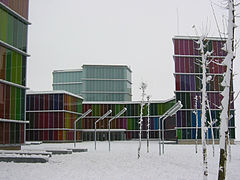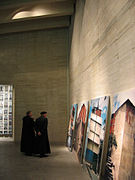|
Museo de Arte Contemporáneo de Castilla y León42°36′24″N 5°34′56″W / 42.60667°N 5.58222°W
The Museo de Arte Contemporáneo de Castilla y León, better known as the MUSAC, is a contemporary art museum in the city of León, Spain. Inaugurated in April 2005 by Felipe, Prince of Asturias, this cultural institution aims to be a "Museum of the Present", in the words of its curator Agustín Pérez Rubio, and thus only collects artworks from the latest generation of artists, between 1992 and 2012.[1][3][4] The museum has won international prestige for its 21st-century collection and innovative programming, being labelled, for example, as "one of the most astonishingly bold museums to hit the Spanish cultural landscape in years" by The New York Times.[3][5] The MUSAC building is celebrated for its avant-garde architecture, and it has been awarded a number of prizes, such as the 2007 European Union Prize for Contemporary Architecture (Mies van der Rohe award).[6] Designed by the architectural studio of Luis M. Mansilla and Emilio Tuñón (Mansilla+Tuñón Arquitectos), the multicolored panels that adorn the exterior of the museum resemble the stained-glass windows of a cathedral. The architects drew their inspiration for this work from the main rose window (called The Falconer) at the local 13th century Gothic cathedral, Santa María de León.[1] MUSAC has become a landmark for the city of León,[1] and an emblem of the new 21st century Spanish architecture,[3] as showcased in a 2006 exhibition at the MoMA of New York City (On-Site: New Architecture in Spain), which selected the MUSAC as one of the arquitectural projects that make Spain today "an international center for design innovation and excellence".[7] Gallery
References
External linksWikimedia Commons has media related to MUSAC. |
||||||||||||||







